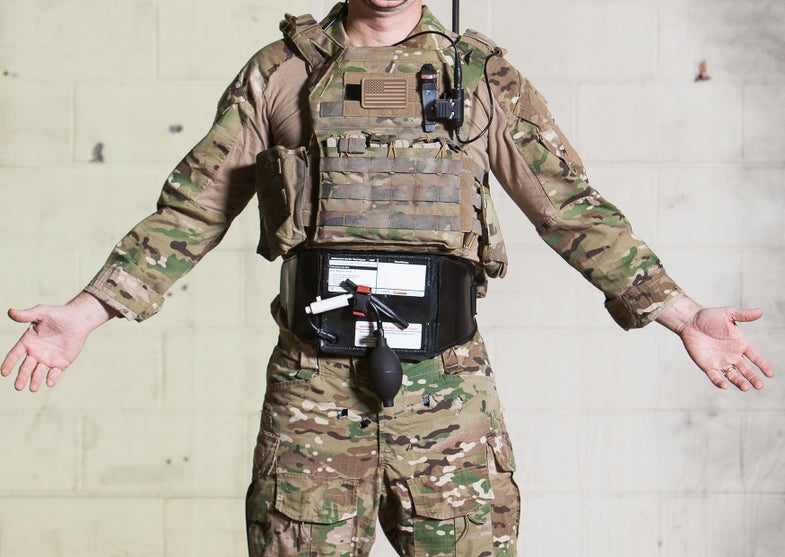Ingenious Tourniquet Invention Saves Lives
An inflatable abdominal tourniquet recently revived two men who were moments away from bleeding to death. The device could have saved three soldiers per month between 2001 and 2010, the U.S. Army says.

On June 7 in Birmingham, Ala., a blood-soaked, unconscious 41-year-old man arrived at a hospital in the passenger seat of a car. The man had lost 75 percent of his blood through two bullet holes in his armpit, and when nurses pulled him from the car at 4:50 p.m., he was less than 5 minutes away from dying.
At 4:53 p.m, a former Army surgeon and inventor named John Croushorn strapped an inflatable tourniquet around the limp man’s chest. “We were all covered in blood. The nurse was applying pressure, and I told her to remove her hands,” Croushorn tells Popular Science. “She said ‘No, blood’s just going to go everywhere again.’ And I said ‘It’s okay, you can take your hands away.’ So she did, and she was shocked. There wasn’t a drop of blood coming out once the tourniquet was on.” They rushed the man to the operating room, where a surgeon was able to repair the damage to his arteries.
“I would have been the doctor to tell his mom, ‘I’m sorry, your son has passed away,’ ” says Croushorn, who has spent the past six years perfecting his wedge-shaped tourniquet invention. “That weekend, I went to check on the guy at the hospital, and I got to meet his mom and dad. His mom just walked over and gave me a big hug and thanked me for saving her son’s life.”
***
Croushorn’s fanny pack-like tourniquet (which won a 2012 Popular Science invention award) received FDA approval in 2011 and saved its first two lives this summer. The invention solves a problem that has long haunted combat medics and emergency room doctors. When a patient suffers a junctional hemorrhage—severe bleeding from the groin, pelvis, shoulder, or base of the neck—he or she often dies because it is impossible to tie a conventional tourniquet tight enough around the torso to cut off blood flow.
“I would have been the doctor to tell his mom, ‘I’m sorry, your son has passed away.’ “Croushorn and co-inventors Richard Schwartz, the chairman of the emergency-medicine department at Georgia Regents University and a former combat medic, and Ted Westmoreland, a former medic with U.S. Army Special Operations, became all too familiar with junctional hemorrhages during their deployments overseas. Enemies would often target the pelvis and upper legs because body armor doesn’t always cover that area, and the U.S. Army cites junctional hemorrhage as one of the most common causes of death on the battlefield.
This new tourniquet stops heavy bleeding with a clever, yet incredibly simple, mechanical design: A medic buckles the device around a patient’s abdomen, over the belly button, and then tightens it by twisting a windlass. A hand pump inflates a wedge-shaped bladder, which displaces the bowel and compresses the patient’s aorta against his spine, halting all blood flow to the lower body. According to a recent Army report, a device like this tourniquet could have prevented an average of three military deaths every month between October 2001 and April 2010.

Abdominal Aortic Tourniquet in position to block bleeding from shoulder
Two coincidences thwarted what would have been certain death for the Alabama man: He arrived at the hospital less than an hour before Croushorn’s shift ended—no one else on staff would have known to grab the tourniquet from Croushorn’s office. What’s more, research at the Medical College of Georgia had just recently suggested the device could be used to stop bleeding from the shoulder.
A few weeks before the shooting in Alabama, the Abdominal Aortic Tourniquet saved a man in Afghanistan who was moments away from dying after losing both his legs in a blast from an improvised explosive device. The man is now recovering with his family.
***
Schwartz and Croushorn got the idea for an inflatable device at a medical conference in 2006. They soon began working with Westmoreland and testing early prototypes on themselves. “At one point, Richard strapped a textbook to his stomach and put a regular blood pressure cuff underneath. His wife texted me a picture of him lying on the floor,” says Croushorn, who politely describes wearing the device as “very uncomfortable.”
It’s impossible to tie a conventional tourniquet tight enough around the torso to cut off blood flow.In October 2011, they applied for FDA approval, expecting the process to take three years. “Eight days later, the FDA told us they had accepted all our research,” Croushorn says. “We hadn’t even lined up a manufacturer yet.” (Read more about how they invented the tourniquet in the June 2012 issue of Popular Science.)

Soldier Saver
The U.S. Army immediately ordered 60 tourniquets for combat medics in Afghanistan, with the first batch delivered to troops last summer. Since then, Croushorn’s company has sold another 150 devices to U.S. and foreign militaries. European Union regulators certified the Abdominal Aortic Tourniquet in May 2012, and now special operations teams in the UK, Netherlands, Austria, Germany, France, and Sweden all carry the device.
Schwartz, Croushorn, and Westmoreland have each lost patients and friends to bleeding that could have been stopped with their invention. “I remember an individual who was shot in the groin,” Schwartz told Popular Science last year. “We were doing all kinds of things while getting the patient to the operating room, but even though we were in a level one trauma center, the patient bled to death because there wasn’t a way to get to the OR in time. This device gives us time.”